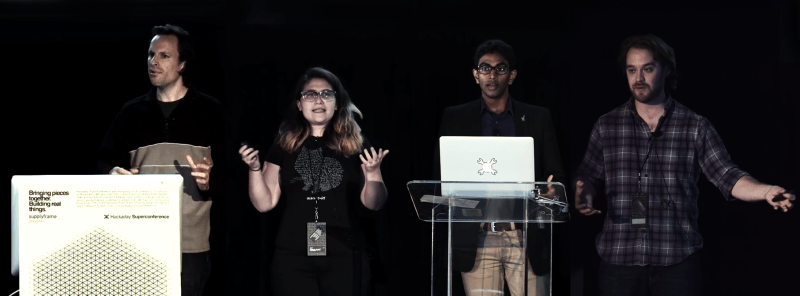The Hackaday SuperConference is the greatest gathering of hardware hackers on the planet. Last year at the SuperCon, we saw talks on building systems from scratch, creating new and interesting uses for technology, and bringing those electronic bits to market. What are we talking about? Here are four of the best talks from last year’s Hackaday SuperConference:
[Shanni Prutchi] is an ECE student at Rowan University, and has already published papers on radio astronomy and metrology. Her talk provides an overview of building her own source of quantum entangled photons and how these photons can be used. Quantum Key Distribution is possible on a small-scale, and not just in the realm of university optics labs.
The best conference talk I’ve ever seen came from [sprite_tm] last year. He created a Matrix of Tamagotchis. Tamagotchis — those loveable digital pets living in an embedded system — are really just computer code, after all, and after reverse engineering the Tamagotchi itself, he emulated several on a server, giving them the ability to communicate with each other and even have children. The best part? [sprite]’s Matrix isn’t a weird almost-perpetual motion machine demanded by studio execs.
Building one of something is easy, but building a thousand is a million times harder. This is the problem of manufacturing electronics, and no one covered it better than [Zach Fredin] and his talk on pilot scale production. The first step of manufacturing is always the hardest, and for [Zach] that was pilot scale production. In the talk, [Zack] gave a few tips like always springing for a stencil, where to get boards manufactured, and the ins and outs of EDA software.
Haptic interfaces are the next frontier. Eventually, we’re all going to be wearing our computers, and [Neil Movva]’s talk on haptic technology was the state of the art in interfaces based on touch. He had some hardware to demo at the conference, demonstrating how different vibrations can feel like different textures. It’s weird, and at the forefront of technology.
We Want You To Speak At This Year’s Supercon
![]() These are just a few examples of the best talks from last year’s Superconference. They’re the cream of the crop, but it’s a new year and we’re looking for the latest and greatest from the Hackaday community. We know we have the most technically literate, adept, and knowledgeable hardware community out there, and we want to showcase that knowledge. Send in your proposal now and share your knowledge with the Hackaday community.
These are just a few examples of the best talks from last year’s Superconference. They’re the cream of the crop, but it’s a new year and we’re looking for the latest and greatest from the Hackaday community. We know we have the most technically literate, adept, and knowledgeable hardware community out there, and we want to showcase that knowledge. Send in your proposal now and share your knowledge with the Hackaday community.
The 2016 Hackaday Superconference is happening on November 5th and 6th, in Pasadena, California. View all the talks from 2015, get excited, and get your proposal submitted!
















What about ectrostatic generation of sensations for haptics?
a la:
https://www.disneyresearch.com/project/teslatouch/
I thought that concept was included in Neil Moova’s talk. Did you watch it?
I think I talked about piezoelectrics, but not much about electrostatic vibration. The latter manipulates charge on a surface to exert rapidly varying electrostatic forces on the user’s finger – truly a unique scheme that should allow great resolution in terms of possible sensations.
It’s fairly new to the scene from what I can tell, with the exceptionally creative teams at Disney being the first to demonstrate a proof of concept. I did want to focus my talk on “wearable” haptics, and generally on-body systems don’t mix with high voltages, as I mentioned in the cons to piezoelectric haptics. Also, this (“teslatouch”) scheme might be better suited to a static installation, since I feel like the sensation produced is most apparent when sliding one’s finger over the charged surface (think touchscreens). I’m not sure using a small charged pad on the wrist or fingertip (my personal use case with the Pathfinder project) would do the tech justice.
Definitely cool tech though. More generally, I do see a future in using tiny electric currents through skin to produce sensation – it seems a viable, minimally-invasive version of the nerve-computer interface we’re ultimately after. Of course, this awaits much more research, and I don’t even want to think about the years of safety testing we’ll need :)
Paragraph 2 line 2
” Her provides an overview of building her own…..”
Her paper? Talk, project? Seems like there’s a word missing here.
“and after reverse engineering the Tamagotchi itself” – building on the massive foundation of Tamagotchi reverse engineering by Natalie Silvanovich (credited in the video)